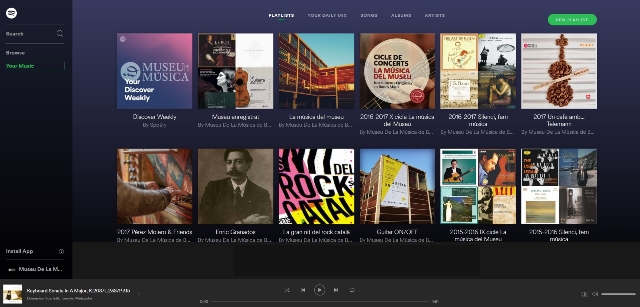
News
The museum in your ears: the use of Spotify
On July 11, 2013 we debuted in the world of social networks with, among other things, our first tweet. It might have seemed easy because the way was opened by many other institutions that preceded us and, at the same time, just difficult to find space between all of them.
It was that same year that we proposed an analysis of the diversity of existing networks and the potential that each one could offer us. In the case of Spotify there was no doubt: being a museum specialized in music, we not only wanted to have the possibility (still to develop) of hanging audiovisuals on the Youtube platform of some of our concerts (and where we have been creating several thematic lists), but we wanted to generate musical playlists with our programming as a base. And at the same time, we wanted to reach a type of audience that is not necessarily interested in social networks, but in listen to music.
On September 12, 2013 we created the first playlist from our profile, was a collaboration with L'Auditori, making a selection of current jazz music in Catalonia, called Ara jaç (Now jazz). And it is there that we began to plan a new way of diffusion of the diverse sound lines of the museum.
Complementing the visit with the music that has been heard throughout the museum is possible with the playlist La música del Museu (The music of the Museum).
The music cycles, as La música del Museu, Un cafè amb... or Silenci, fem música, allow us to recover - as long as the themes are found in the database of the platform - all the pieces that have sounded in the concerts and that have been proposed by the musicians. In this way, we have created a sound archive of the seasons from 2013 until now.

In some cases we have been able to make thematic lists outside the program, in parallel: for Un café amb... cycle, the playlist Cafè, cafè! collects pieces of all types and times where coffee appears as the main element, or DivenDress: peces de roba playlist, where all the songs mention any clothes as theme.
We also wanted to experiment with two types of collaborative playlists: the first, as a wrapper of the DivenDress network project, and made entirely by followers on the networks (with proposals via Instagram, Twitter and Facebook), allowed a sound envelope for couples of costumes and instruments proposed by the Museum of Design and the Museum of Music. The users suggested to us, for each couple, the music that combined better with the visual proposal, so the chronological tour of the objects was completed with the soundtrack, extending the scope of the project. The second, in the celebration of the 10 years of the museum in the building of L'Auditori, No ens la podem treure del cap (Can’t get out of our head), this collaborative list gathers two themes chosen by each person of the Museum team, with the premise that there was no restriction of any kind, but they should be topics that we would like hear ever and, as you will see / hear, the list is quite open.
Temporary exhibitions have also allowed illustrate the sound of some of the contents, such as The Music of the 1714s, Guitar ON/OFF, The great night of Catalan rock or, from the exhibition we have seen in Lleida and in September we will inaugurate in Barcelona, Granados, from Paris to Goya, we have created a list with Granados as the only thread, starting with the music for single instruments until arriving at symphonic music and opera, to know a little better its compositive scope, and later we will create a new playlist over exhibition.
Until now these auditions playlists are almost always done with unique and patrimonial instruments that are part of our fund, which makes everything proposed are always alternatives. Now, our last playlist, Recorded museum, raises just the best approach with Spotify: all the pieces that are played are made with instruments from the museum: a guitar by Antonio de Torres (with Stefano Grondona), the harpsichord Zell (with Ton Koopman and Béatrice Martin), Hauslaib's claviorgan (with Juan de la Rubia), the piano Érard (with Antonio Simón) and several guitars, among them "of the lions" (with Xavier Díaz-Latorre).

